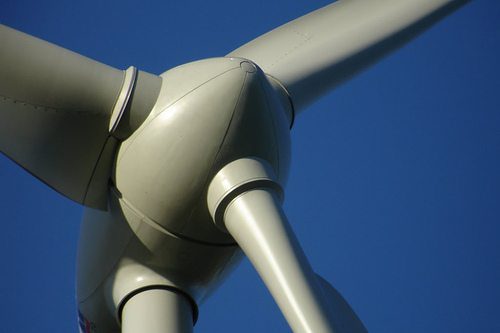On Wednesday the Senate inquiry into excessive noise from wind farms released their report. The inquiry was supposed to focus on audible noise but debate strayed into concerns that wind turbines can cause health problems by producing infrasound (sound of a frequency so low that it is normally inaudible) and low frequency noise.
Wind farm opposition groups such as the Waubra Foundation are prone to making extreme statements about wind turbines such as this from their senate inquiry submission “…characteristic symptom patterns have been reported at distances up 10km away from the nearest wind turbine.” Infrasound is blamed and understandably people get concerned.
So where does this idea come from? The Senate inquiry gives us the answers. Submissions represent a global who’s who in the debate on wind farms and health. Often information provided to support the wind-farms-cause-health-problems idea actually demonstrates the opposite.
Take for example Figure 1, presented by Steven Cooper of the Acoustic Group in senate inquiry submission no. 142. The Acoustics Group is used by opponents to wind farms in support of their submissions opposing proposed wind farms including: the Flyers Creek wind farm project in New South Wales and the Stony Gap and Hallet 3 projects in South Australia.
In presentations promoted by Senators Xenephon and Madigan, Cooper has quickly flashed through this graph and others in order to bolster the case that wind turbines could be causing health problems. I went to his presentation in Bacchus Marsh on 13th of June this year and witnessed this. Rather strangely, Cooper refused to provide a copy of his presentation even though he had just publicly presented it, despite requests from many members of the audience. What’s the secret? Particularly when Cooper goes to great lengths to say that “If there is potential for an industry to jeopardise the welfare, health or safety of the public, or affect the well being of the community I am duty bound to identify those issues under the Code of Ethics of the Australian Acoustical Society.” (inquiry submission no. 142).
Examination of Figure 1 shows that peak infrasound (sound below 20Hz that cannot usually be heard) recorded by Cooper inside a house near to a wind farm was about 50dB at very low sound frequencies of around 2Hz, fading quickly to almost nothing at 8Hz.
Now compare this to Figure 2, which shows the lowest threshold of ear sensitivity (the thick line on the lower edge of the grey shaded area) that Alec Salt believes is possible after tests conducted on cats and guinea pigs. Coopers recordings are well below Salt’s sensitivity threshold. This is significant given that Alec Salt’s work is also often relied on by wind farm opponents to support the idea that wind turbines are detrimental to health. Perhaps this is the reason for Cooper’s secrecy.
A second problem with the information presented by the Acoustics Group is also evident. Cooper did not isolate the cause of infrasound to wind turbines. He could simply be recording something else. To resolve this he needs to present data comparing infrasound with turbines on and off.
Figure (1) Infrasound measured inside a residence near to turbines by the Acoustics Group.
This shortcoming also resides in figure 2. Salt shows infrasound and low-frequency noise measurements from near wind turbines recorded by Van den Berg (2006) and Jung and Cheung (2008). By including this data in his graph Salt shows that very low frequency sound emissions from wind turbines could potentially be sensed by the ear even if inaudible. However neither Van den Berg or Jung and Cheung isolated the cause of infrasound by measuring with turbines turned off vs turbines turned on. They could have been measuring infrasound and low-frequency noise caused by the wind.
Infrasound and low-frequency noise measurements have however been conducted with wind turbines turned on versus turned off. Hepburn (2006) comprehensively measured infrasound around a wind farm in Alberta, Canada. Hepburn’s recordings 50m from wind turbines under high wind conditions (see below) show that the levels of infrasound and low-frequency sound recorded were very similar whether turbines were turned off or on as shown in figure (3).
In fact higher sound levels were recorded with turbines turned off versus when the turbines were running. A strong indication that the origin of most infrasound and low-frequency noise was the wind itself which was slowed by running turbines. Interestingly the results shown in figure 3 are consistent with the infrasound and low-frequency noise results shown by Salt in figure 2.
Infrasound from wind turbines is extremely unlikely to cause health problems, however wind turbines do on occasion cause annoyance due to audible noise. For example Van den Berg (2006) discusses a ‘beating’ phenomenon at one wind farm which could be amplitude modulation misinterpreted as an infrasound issue. Such phenomenon have resulted in changes to wind turbine noise standards in order that residents around wind farms are protected. For example the updated New Zealand Noise Standard 6808:2010 address amplitude modulation. Responsible changes are made to genuine problems. Those concerned about wind turbine noise should focus on audible noise and need not work themselves into a worry about infrasound.
Richard Mackie has a BE and ME in mechanical engineering majoring in control systems from the University of Auckland and an MBA from the Australian Graduate School of Management. He is the principal of Advanced Energy Consulting and consults to the wind energy industry.











